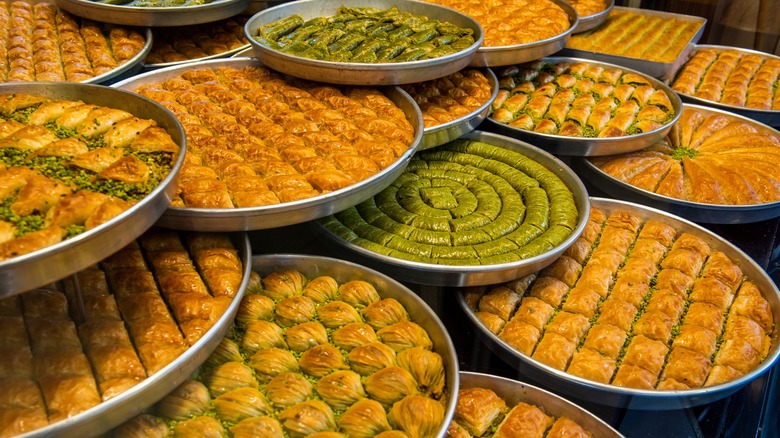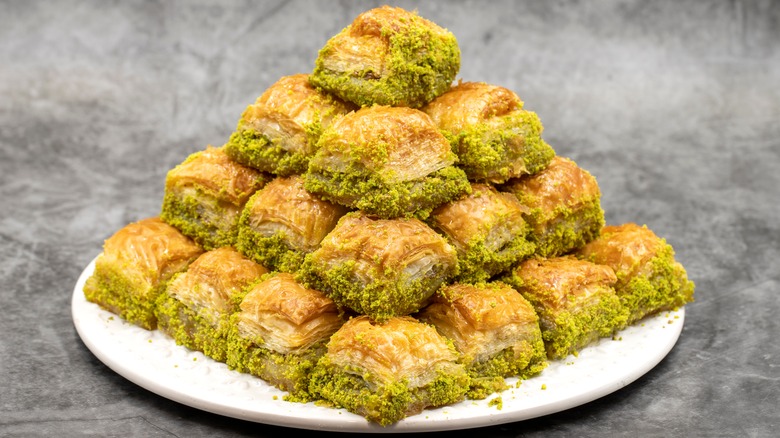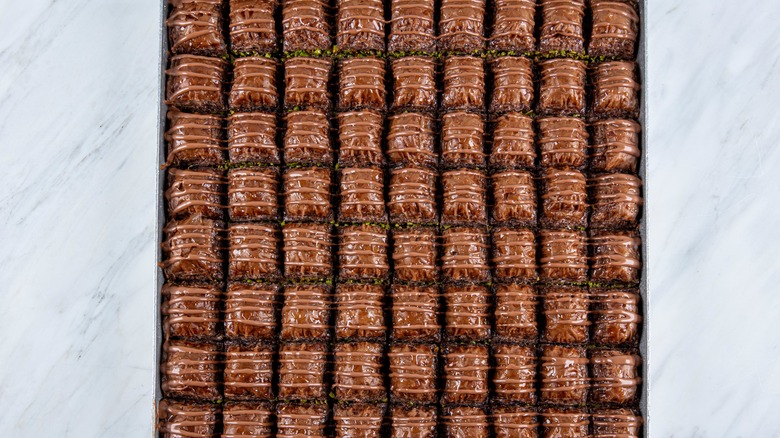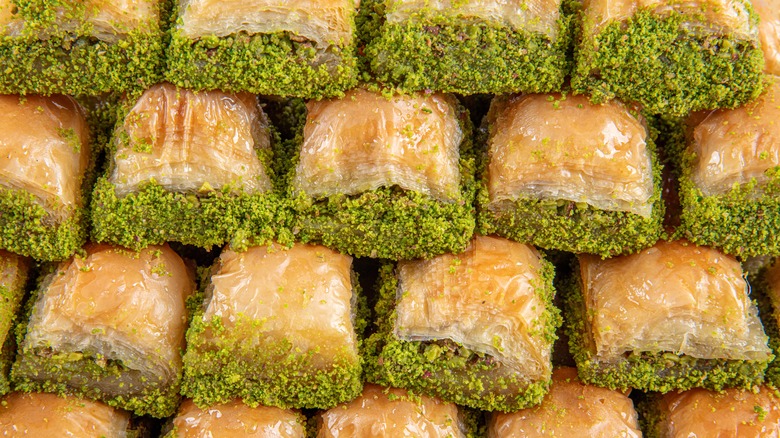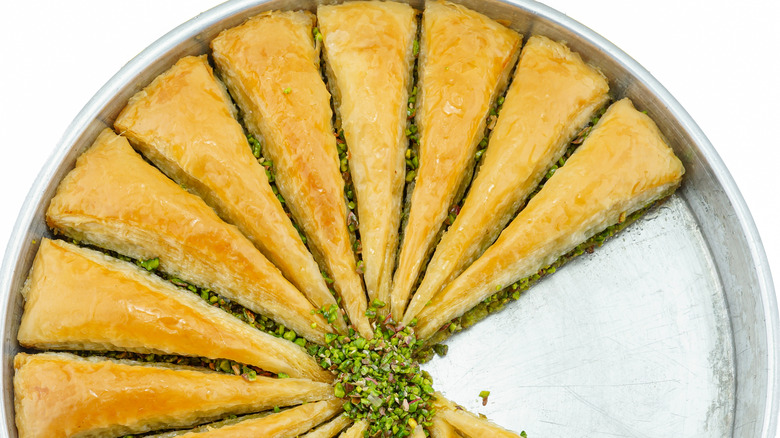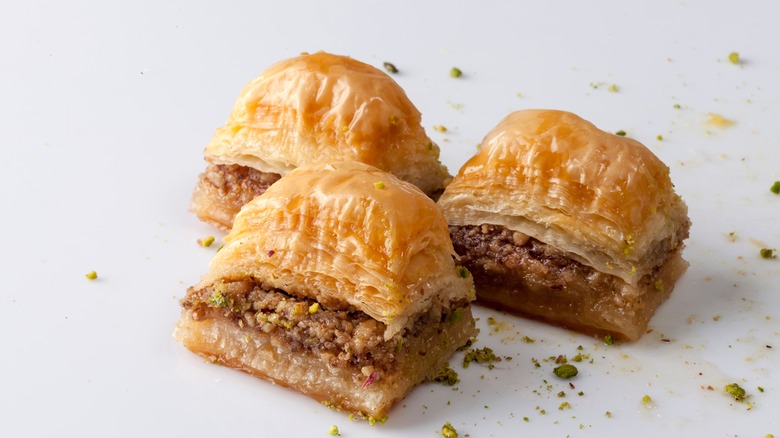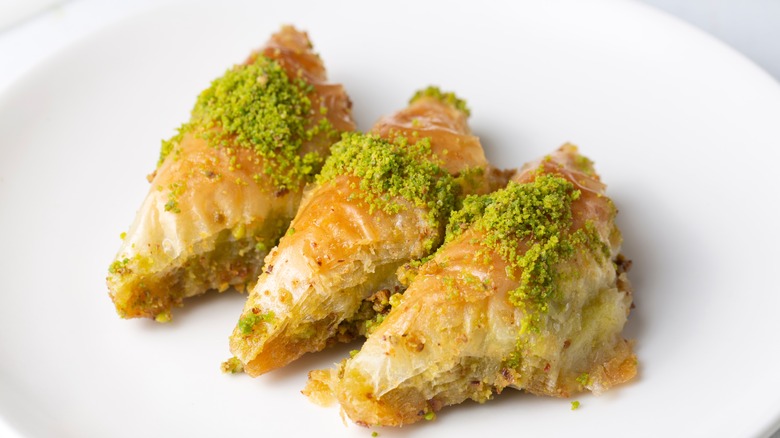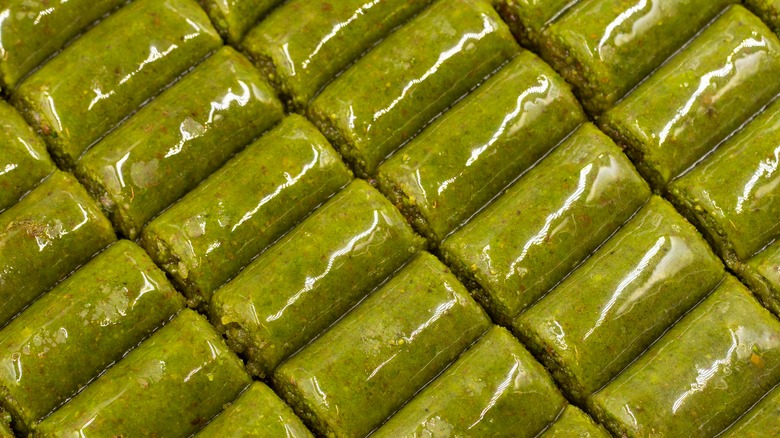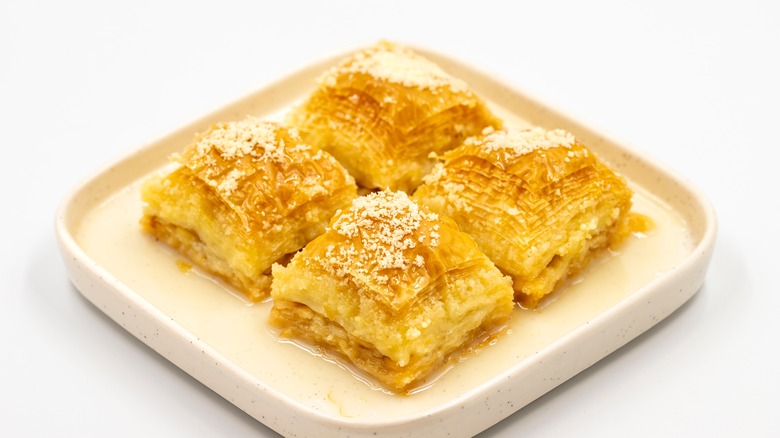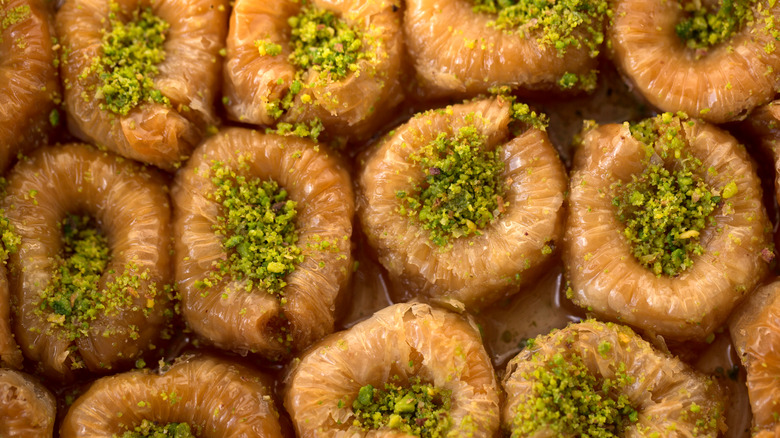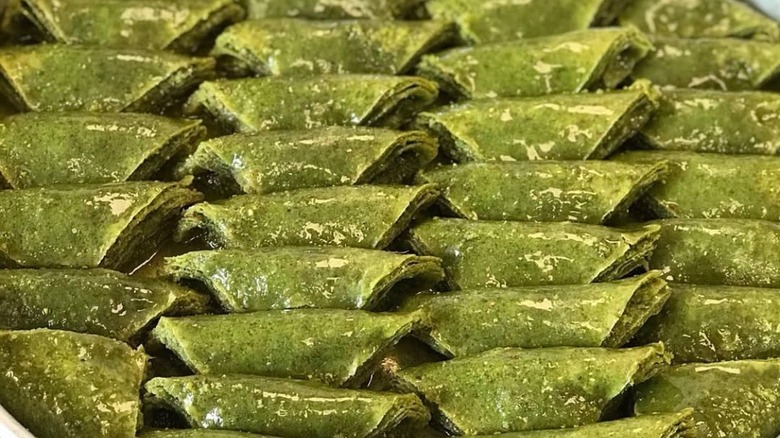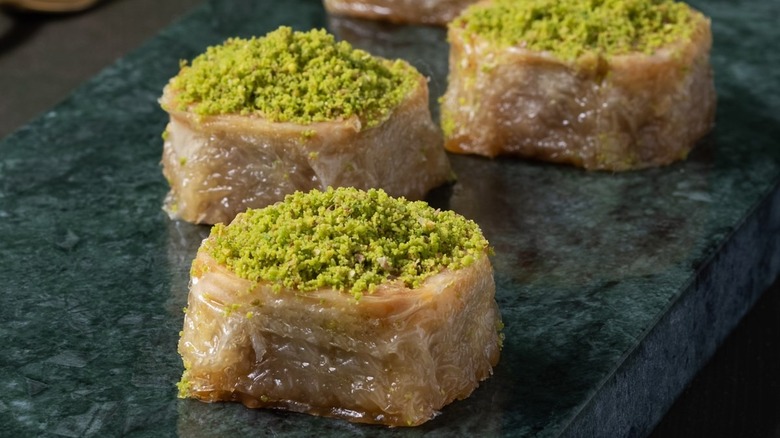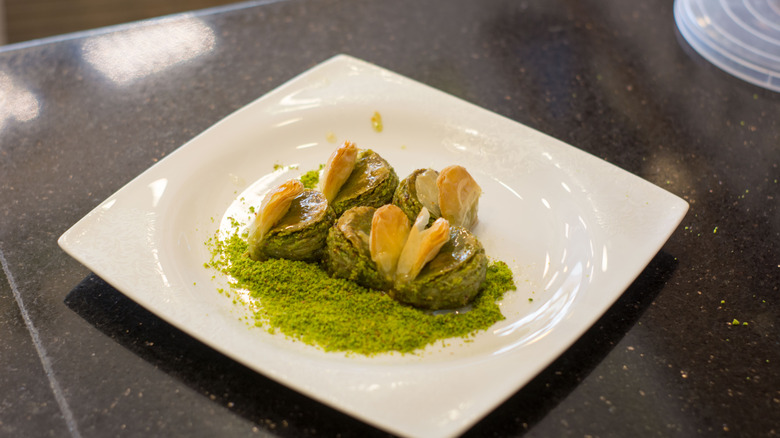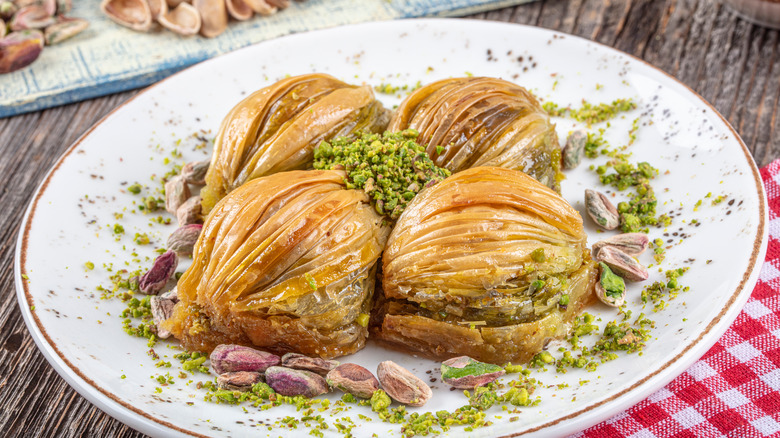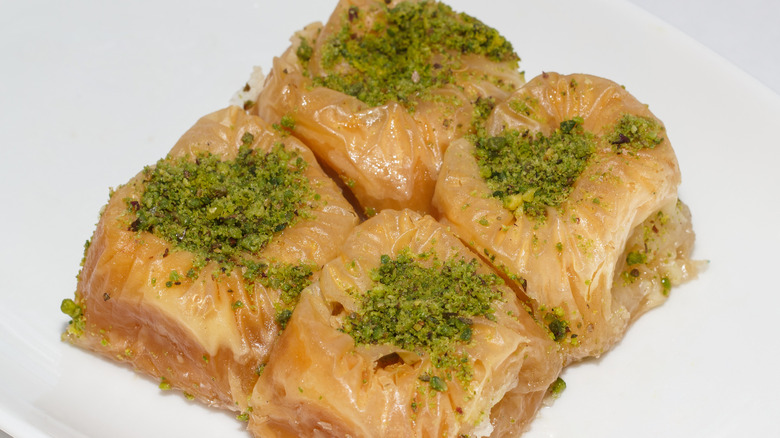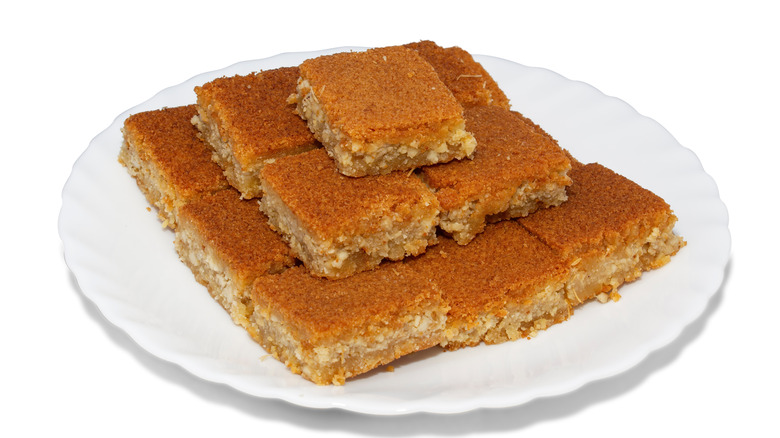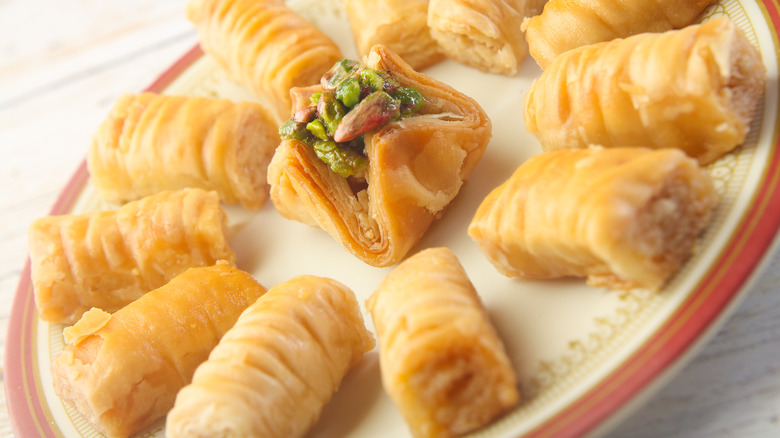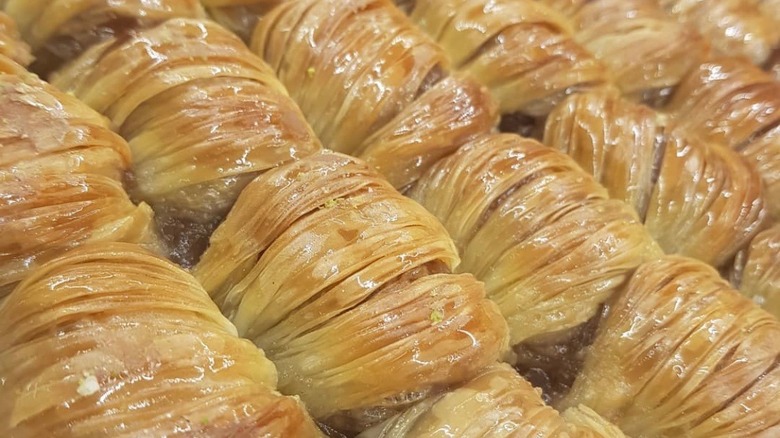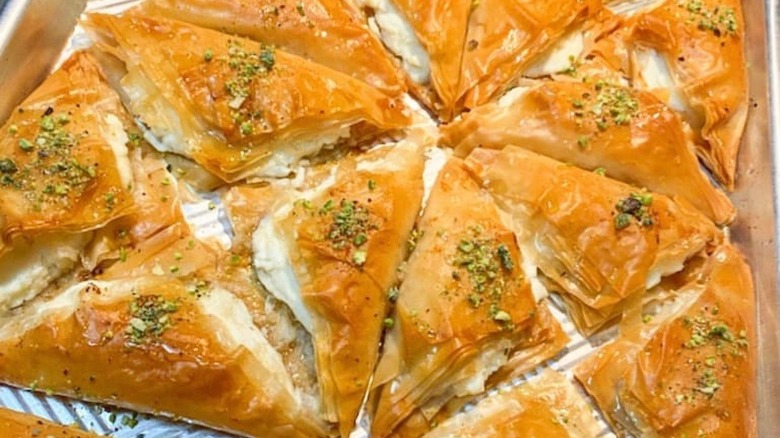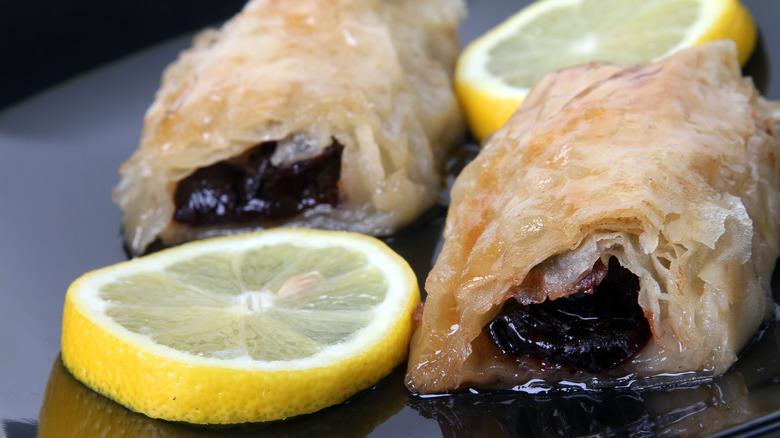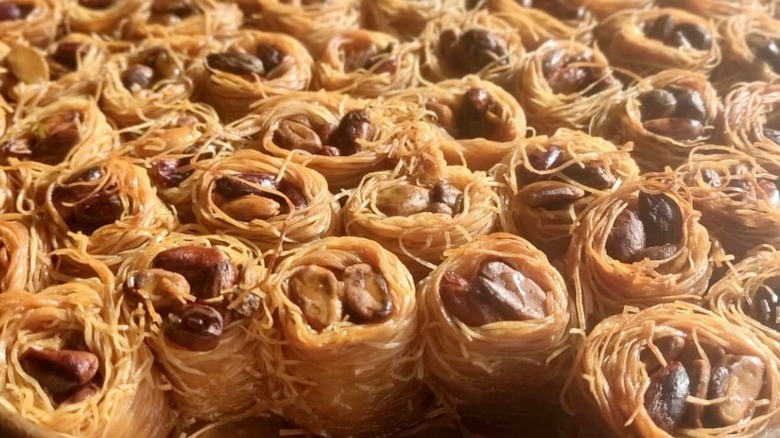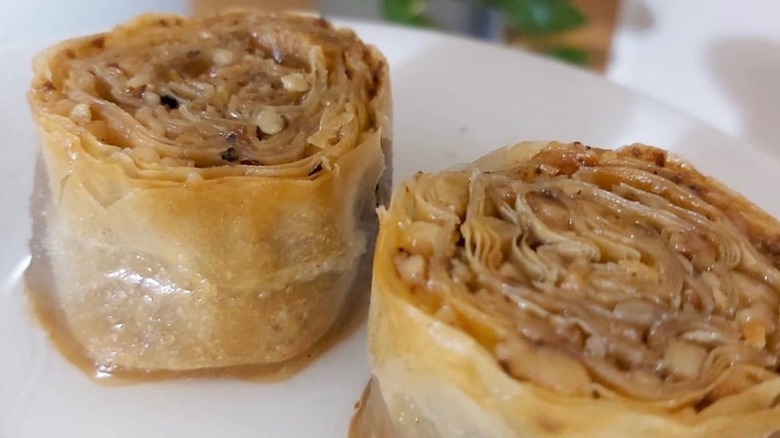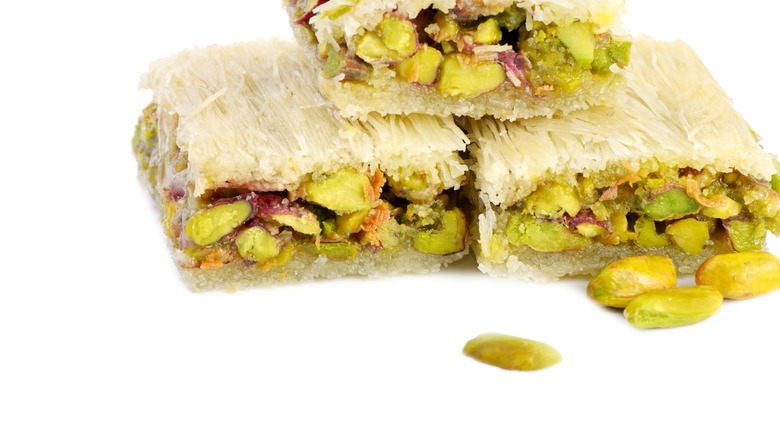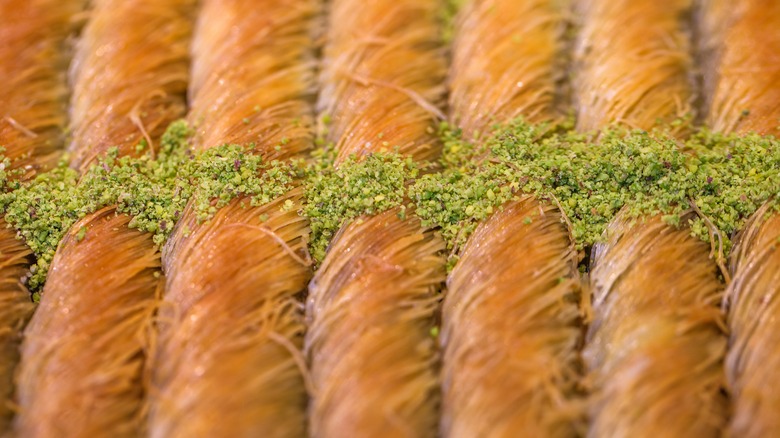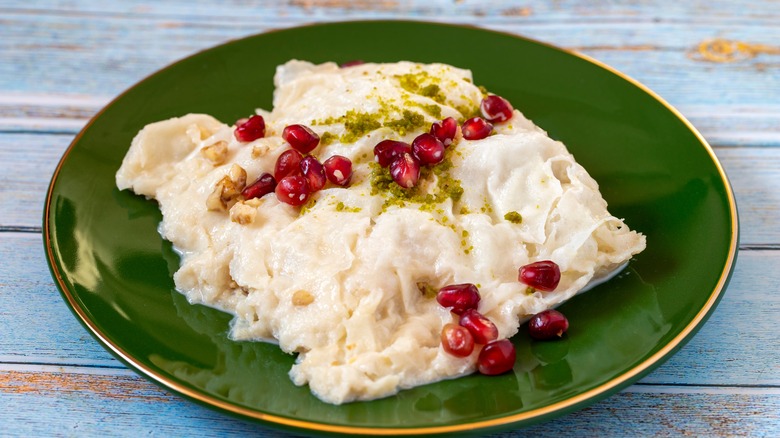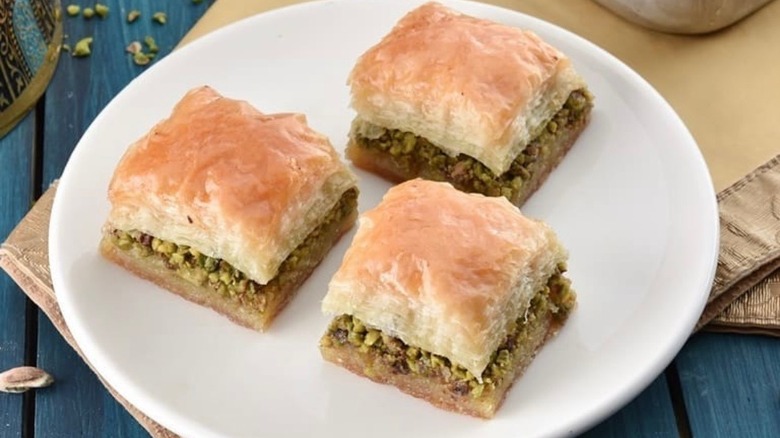25 Variations Of Baklava, Explained
Baklava is a Middle Eastern dessert commonly associated with countries like Turkey and Greece. The tradition of making unleavened dough and layering it with sugar and nuts dates back to the 8th century. The exact origin of baklava is still contested, but historians point to Turkey, and the Ottoman Empire before the treat was eventually spread across borders into Greece. The first baklava was believed to have religious roots, as Greek baklava is typically made with 33 layers of phyllo dough to signify the age of Christ. Baklava is often eaten during Muslim Ramadan and Eid ul-Fitr, as well as Christmas (via Bodrum NYC).
While baklava's exact filling and ingredients depend on the country and preparation, there are a few main components of standard baklava. The first is phyllo dough, an unleavened thin sheet that gives the pastry its flakiness, sugar (such as syrup or honey), and nuts. The brevity of baklava variations includes different spices, soaks, and shapes. Here are some of the most popular variations of the baklava you may see in an ethnic bakery.
Pistachio baklava
Pistachio baklava is one of the most standard types of baklava you'll find. These pastries are made with pistachios, which grow plentifully in the Mediterranean region, and are cut into square or diamond shapes before serving. The soaking mixture for pistachio baklava is very simple and includes sugar, lemon juice, and water — which is heated until sticky before being poured over the sheet of stacked phyllo and pistachios. This baklava is very mild flavored, and the pistachios provide a bit of an earthy undertone.
Chocolate baklava
Chocolate baklava has many variations within itself. Some chocolate baklava recipes stick to using a blend of hazelnuts and chocolate-hazelnut spread to impart nutty, chocolatey flavors on the pastry, while others will mix chopped bittersweet chocolate in with the walnut, almond, hazelnut, or pistachio filling. You may also see a drizzle of chocolate on the top of each pastry for a bit of crunch and a sweet chocolate flavor. Many chocolate baklava recipes will also infuse orange into the glaze on this pastry or add a bit of clove into the nut mixture to complement the chocolate.
Kuru baklava
One of the distinguishing characteristics of baklava is its sweet, syrupy coating. But in the case of kuru baklava, the thin syrupy coating is swapped out with a thicker, denser sugar coating that dries the baklava on contact. Kuru baklava tends to be sweeter than traditional baklava and highlights the flavors of the nuts and phyllo rather than the syrup itself. The Nomadic Husband notes that kuru baklava has a longer shelf life than other baklava because it is made without milk in its dough. Additionally, kuru baklava tends to be a bit lighter than other baklava varieties, which makes them a perfect snack if you're traveling through the region. Kuru baklava can be made with any blend of nuts, although pistachio remains one of the most popular fillings.
Havuç Dilim baklava
Havuç Dilim baklava, or carrot slice baklava, is traditionally made with 30-layer phyllo dough and copious amounts of pistachio filling (via Turkish Taste). Unlike other baklava types, which are sliced into squares or diamonds, the carrot slice baklava is sliced into triangles — which are slightly larger than other servings of baklava. Carrot slice baklava can come in both dry and traditional forms and tend to have more buttery flavors than sweet ones.
Cevizli baklava
Cevizli baklava is all about the walnut filling. These Turkish baklavas are made with layers of phyllo and a mixture of chopped walnuts, cinnamon, sugar, vanilla extract, and water. Typically these baklavas are sliced into small squares and covered with syrup made from lemon juice and honey. Cevizli baklavas are relatively dense and sweet, thus making them the perfect dessert pairing for Mediterranean dishes or served alongside a warm cup of tea or coffee.
Şöbiyet
Şöbiyet is Turkish baklava made with the inclusion of a dairy-rich ingredient: cream. According to Safir Bakery, söbiyet in Arabic means "to eat, to be full," which we can assure you will happen if you eat enough of these treats. Like baklava, söbiyet is made with phyllo dough, walnuts, and a syrup coating but includes a layer of cream called kaymak. Kaymak is made by mixing semolina and milk, which gives a subtle sweetness and earthiness. Şöbiyet is traditionally served with ice cream and can be found in bakeries across Turkey.
Baklava made with a cream layer in the dough is called "wet baklava." Because of the inclusion of a perishable milk product, the wet baklava has a shorter shelf life than "dry baklava" — which is made without cream.
Fıstık sarma
Fıstık sarma is otherwise known as fıstıklı dürüm or fıstık dolması. This Turkish baklava places a strong emphasis on pistachio flavor and is made with both a blend of crushed pistachios as well as fıstık ezmesi, a marzipan-like pistachio butter. Fıstık sarma is commonly called a pistachio roll because of its shape, which is made possible by the use of a single sheet of phyllo dough to hold the pistachios, fıstık ezmesi, and syrup coating together.
Sütlü Nuriye
Sütlü Nuriye is a milky type of Turkish baklava made with crushed hazelnuts. Rather than being coated entirely with a sugar coating, baklava bakers combine milk with a little bit of sugar for sweetness and pour the concoction over the baked pastry. This contributes to the light color of the Sütlü Nuriye compared to traditional Turkish baklava. According to Ozlem's Turkish Table, the most likely reason bakers started to use hazelnuts in this baklava variation rather than the traditional pistachios was because of a major supply shortage in the 1980s. The inclusion of milk accentuates the softness of the hazelnuts and makes for a much lighter baklava.
Bülbül Yuvası
Bülbül yuvası, or nightingale's nests, are disc-shaped baklava found in Turkey, the Middle East, and Europe. Unlike other types of baklava that stack phyllo sheets on top of one another, bülbül yuvası are made by wrapping the phyllo dough around a thin rolling pin to resemble a nest-like shape (via But First Chai). After the pastry has been drenched in syrup, the center of the baklava is filled with chopped pistachios or walnuts; there is no nut filling inside the phyllo itself. The syrup can be flavored with aromatics like cardamom, rose water, or orange blossom water, depending on the region in which it is prepared.
Yaprak Şöbiyet
According to Authentic Turkish Baklava, there are many similarities between yaprak söbiyet and söbiyet, including the layer of kaymak. Yaprak söbiyet, also called leaf söbiyet, is the excessive amount of pistachios stuffed into the pastry. The most common pistachio type used for the yaprak söbiyet is the green pistachio, which is one of the most expensive types of nuts in the world due to the resources the plant requires, as well as the labor necessary to hand-sort the nuts.
Saray burması
Saray burması is a unique baklava type that is also referred to as palace baklava. According to Dedeglou, the place wrap baklava is made by cutting the phyllo into round shapes and filling it with crushed walnuts. After baking, the rolls are coated in syrup from sugar beets and sprinkled with a garnish of finely ground pistachios. Karaköy Güllüoğlu notes that the palace roll is usually made with a three-layer phyllo.
Dilber dudağı
Dilber dudaği is a uniquely shaped variation of baklava common in Turkey. According to Nomad Paradise, these baklavas get their name, "lady's lips," from rolling and folding the baklava into clamshell shapes before baking. Dilber dudaği are most commonly filled with pistachios or walnuts and covered in thin syrup. According to the Turkish Porter, dilber dudaği's sherbet (the fat that binds the layers of phyllo together) is cold-poured, rather than traditional baklava's sherbet method of hot-pouring the binder onto the dough sheets.
Midye Baklava
Midye baklavas are also called mussel baklava because of their unique, pinched ends and layers — which almost resemble a garlic clove. Mussel baklava is made with very thin layers of phyllo sandwiched between chopped pistachios and pistachio cream. There are also very few layers of pastry used in this type of baklava, which makes it distinct from other shapes of baklava sold in Turkey. This baklava type is very pistachio-forward and distinct in its design (via Aladin).
Asawer
Asawer are Lebanese baklava that resemble the Turkish bülbül yuvası (via Libanais Sweets). "Asawer" translates to "bracelets" in Lebanese, which eludes to the thin shape of these baklavas. Asawer is a relatively small and light baklava made by shaping pieces of phyllo into discs before using a rod to flip the dough in half. These baklavas are filled with pistachios but dusted with a light layer of raw pine kernels. After the pastry is shaped into a bracelet-like circle, it is covered in sweet syrup and garnished with crushed pistachios and pine kernels.
Basma
Basma, according to Libanis Sweets, is the Lebanese word for "a smile." These baklavas are shaped differently than other types of baklava and are significantly heavier in taste and weight than other varieties. The dough for the basma is called knafeh. Knafeh dough is made by mixing flour and water and placing the mixture through a series of pots and filters to render long strands of dough. For a basma, the knafeh is grounded down into sheets and layered with pistachios, pine kernels, and almonds. Like other baklava varieties, ghee is the primary ingredient to sandwich the pastry's layers together. After baking, the basma is topped with a layer of sweet syrup and garnished with ground nuts.
Finger baklava
You'll see variations of these finger baklava across the Mediterranean, Middle East, and Northern Africa. However, you might also be confused when you see baklava and baklawa next to one another. Greek baklava, though, is usually coated with a honey glaze, while Arab baklawa (same food, different spelling) is coated with an infused glaze (via Simply Lebanese). Regardless of the coating of these baklavas, the process of stuffing and shaping them is very similar. Damp sheets of phyllo are placed down, and the nut filling (usually a mix of chopped walnuts and pistachios) is placed in a log shape on one end of the baklava. The pastry is then rolled like a cinnamon roll to the other side. It is then baked, covered in the respective syrup, and sliced into small logs for serving.
Kestaneli baklava
Kestaneli baklava has one major unique characteristic: the filling is made with candied chestnuts rather than pistachios, walnuts, or almonds. In Turkey, the candied chestnuts are called kestane şekeri. According to the Financial Times, chestnuts are a symbolic food in Turkey that have roots in the country back to the times of ancient Sardis. In the city of Bursa, you'll find vendors selling candied chestnuts during the winter season, along with the sweet baklava treats stuffed to the brim with pulverized or whole candied chestnuts sweetened with sugar. The humble pistachio does appear in this baklava variety — but only as an occasional garnish.
Baklawa bil jibna
Baklawa bil jibna are an Arabic preparation of baklava often eaten in Libya. Instead of being filled with nuts, these baklawa are filled with a sweetened cream cheese called Jibn Akawi. In Arabic baklawa fashion, the cream of this baklawa can be sweetened and flavored with rosewater. The rosewater syrup poured onto the finished baklawa is floral, bright and provides a lighter flavor than nut-filled baklawa varieties. Baklawa bil jibna is commonly eaten during the Muslim holiday of Ramadan.
Vişneli baklava
Vişneli baklavas are filled with a non-nut filling that provides a subtle sweetness amid sour notes. Sour cherries are wrapped in layers of phyllo dough and covered with lightly sweetened syrup. Lemon and poppyseed are two common flavor accompaniments for this type of baklava; the poppyseeds can be mixed into the filling itself while the lemon juice is added to the syrup coating to deflect some of the sweetness from the sugar.
Taj al malek
Taj al malek, or "king's crowns," are a type of baklava made with shredded phyllo called kataifi. The shreds are shaped into nest-like cups by drying out the dough for several days in a mold. Before baking, the dough is covered in ghee or butter (this accentuates the golden brown color). The pistachio and syrup filling is cooked separately from the pastry and added to the center of the pastry after baking. Pistachios are the most traditional type of nut used for this recipe, but walnuts or pecans can be substituted as well.
Ružice
Ružice are a Bosnian baklava that resembles its translated name — "rose baklava." The inside of these baklavas are filled with chopped walnuts and tirit: a strudel crumb made from flour, egg yolks, and melted butter. The syrup for the ružice is traditionally flavored with clove, which gives the impression of an American-like coffee cake with walnuts. The pastry is rolled tightly and cut into slices for serving. After baking, the syrup is added to the slices to give the baklava a shine underneath a golden hue.
Ballourieh baklava
Ballourieh baklava is characteristically made with distinct layers of shredded wheat dough (kataifi) baked with a thick layer of pistachios and covered in rosewater syrup (via Baklava Factory). The Ballourieh resembles a sandwich because there are only two layers of kataifi on the top and bottom of the pastry. At regional bakeries in Syria, Jordan, and Palestine, the Ballourieh is only baked lightly so that the pastry retains its white color.
Burma kadayıf
Burma kadayıf is a sweet Turkish baklava made with kataifi instead of traditional sheets of phyllo dough. With this type of baklava, the kataifi shreds are twisted around a nut and sugar filling to create a tube shape. After it is shaped, the pastry can be cooked in a pan or deep-fried until it starts to develop a golden brown hue. From there, the pastry is covered in sugar syrup and coated with a garnish of chopped pistachios. As for the filling, pistachios are always a staple, but the nut can be substituted for walnuts or pecans.
Güllaç
Güllaç is a dessert served in Turkey during Ramadan; some historians have even termed it the proto-baklava. The Güllaç leaves are made with a mix of flour, water, and cornstarch, and these sheets are more gelatinous than phyllo dough and don't crisp up as much. After the first layer has been placed in the pan, the Güllaç leaves are soaked in a milky mix with sugar and rosewater before being layered with chopped walnuts. After all the layers have been set, the dessert is cooled so the layers can soak up the milk. Then, the dessert is sliced into squares, garnished with pomegranate seeds and pistachio dust, and served.
Özel kare baklava
Özel kare baklava is made for the folks who can't get enough pistachios in their baklava. These baklavas are jam-packed with a thick layer of crushed nuts (via Turkish Plaza). Some variations of the özel kare baklava are made with lower sugar content and higher oil content. Moreover, the higher level of fat in the pastry amplifies the nuttiness and savoriness of the pistachios, meaning that you'll be head over heels for the nuttiness of this type of baklava.
